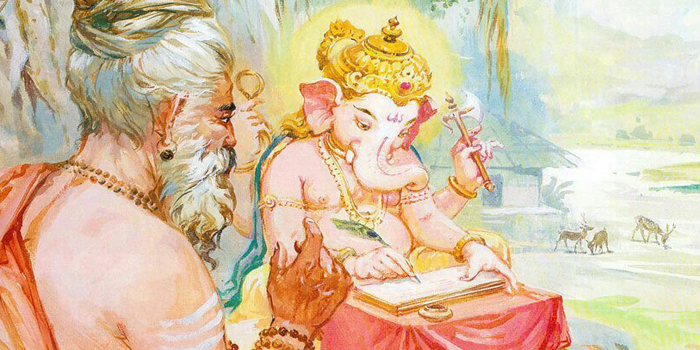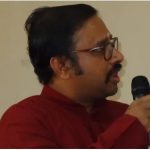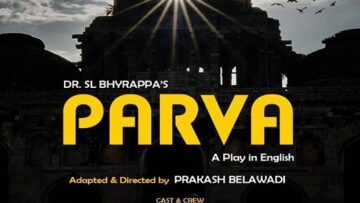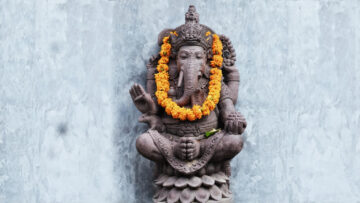Following the announcement of short term research scholarship on the historical context of Creative Liberties in Bhartiya Literature Indic Academy’s research scholar and writer presents a thought essay on acceptance and extent of creative liberties.
As mentioned in the announcement for the scholarship, we are seeing an increasing trend of creative literature in the recent past, that is based on the past Indian oral and written narrative and non-narrative texts. These creative works, in the case of narrative works, introduce changes in various aspects such as modifying events, places, characters, actions, etc. or introducing new events, places, characters, actions, etc.
In the case of non-narrative works, authors are adding their new interpretations to the old texts. The authors of such contemporary works, in some cases, are being admired and in some other cases are being blamed for the changes that they are making. Authors and their admirers defend the changes on the basis of/in the name of the creative liberty of the author.
The problem of Creative Liberty of an author is an all time and universal reality. Where there is art – there is the seeking of Liberty and there is a concern of the appropriateness of the Liberty. Before anything, it is important to acknowledge that the former is a genuine need and the latter is a genuine concern.
Although the problem itself is an all time and universal phenomenon, its solution is not – hence, the problem too has remained an all time one and universal. Every society has resolved it in a certain space, time and context – the ephemeral dEsha, kAla and vartamAna in our tradition – it is ever changing.
Yet, in Bharatamandala there is a discipline through which it has been dealt with – there is a method to this madness. If you look at our heritage, one hardly finds the concept of limiting the freedom of expression. Our ancestors probably did not even think so – for such a concern is not explicitly stated at all anywhere.
No Charvaka was ever put to death. Nobody who wrote a different version of Ramayana – either with creative deviations or manipulative distortions – were ever persecuted. One can give specific examples but let us leave that aside. But the guiding principle has always been a constant engagement between the creator and the recipient.
This process is best represented by the metaphor of Vyaasa and Ganapathi in Mahabharata – which has remained a guiding principle for all creativity in Bharatamandala. At the outset, it seems as though Ganapathi is a mere scriptwriter.
But the story makes it clear that he is part of the project. He is suggested by none other than Brahma, the prime deity of all Srishti – the outpouring of creation. Without him there is no Mahabharata. He is the metaphoric representative of all readers of all time.
Ganapathi’s condition to Vyaasa that if Vyaasa stops reciting a verse he will abandon the project is a clear expectation from the reader that don’t be mediocre. It is a responsibility placed on the composer to be deeply creative and far more imaginative.
Vyaasa’s reverse condition that Ganapathi must understand the verses first and then only put it to writing is another expectation – do not be hasty in putting anything down to writing before internalizing in the right perspective. It may even need an interaction to seek an understanding. Ganapathi asks questions Vyaasa clarifies and so on.
This push and pull applies to the problem of Creative Liberty as well. Before society, readers, critics gain their run-away speed (aka Judging, Trashing) beyond that of the author and trash works of authors, a genuine appreciation is mandatory.
Great art along with great causes suffer with such hasty readers. To this in our times we can add – great social interactions and processes – they will suffer if readers are without artistic empathy.
The story of Vyaasa and Ganapathi is a great metaphor for what is the ideal relationship between the author/artist and the reader/connoisseur. A timeless classic such as Mahabharata requires both Vyaasa and Ganapathi.
Ancient India developed certain disciplines to arrive at a dynamic equilibrium. It was an era when works were composed of a culture and civilization in harmony and continuum. Methods of internalization and engagement with a work were standardized through Vyakhyana, Shastrartha.
Things flowed gradually with a speed that the society could meet without the fabric of harmony being torn. However, in the modern world, this poses a significant challenge.
We are now in a society that is fractured, times far too dynamic, and with conflicting expectations at multiple levels. A single narrative can travel with a speed of light and destructive power of a nuclear process, that can cause severe harm to some sections of the society.
The process is further complicated by illegitimate traders of narratives. This much needs to be acknowledged. Suffice to say that Creative Liberty certainly has a far greater challenge, and artists must recognize this painful truth.
Despite all these concerns, two freedoms must be fully protected for the good of every community and the larger civilization. Without these nothing at all can be achieved in the longer run.
1. Artist’s freedom of expression
2. Reader’s freedom of acceptance.
The real challenge is in managing the conflict between the two, shaping the engagement and maintaining the equilibrium. The cultural environment must provide platforms, opportunities for an engagement between the two and actively shape it. This process has to be reimagined and recreated in each era. The more organic this shaping the better.
It must be shaped without a single/or very minimal written rules or limitations or dogmas or laws. Like in Thailand – there is no rule to say that Buddha cannot be vilified but nobody will ever do so, the sense of sacredness for Buddha is so all-pervasive – society has figured out a way to keep the vilifiers aside.
Making the concern of a community paramount in a civilization requires hard work. Artists must only be soft-bound by this concern. A community must learn to make it difficult for artists to run amok with manipulations and distortions. However, that is possible only when platforms for all are universally available with equal influencing power. In the absence of this balance, conflicts are bound to escalate.
The way ancient India achieved it is by creating a ‘Shastra’ for everything. There was a Vedic era when everything was amUrta – without a physical form. As the Physical forms were imagined under the ambience of Vedic Philosophy, a ‘Shilpa Shastra’ emerged to maintain a continuity of Civilizational Thought and Genius.
This too is an imaginative engagement between the Creative Writers and ‘Shastrakaras’ or ‘Modern Critiques’ – an equally creative interaction. It is an evolving process. This is sorely missed in our times for all modern works of art – such as Fiction Novels or Historical Fictions.
Artistic works are evaluated through the concerns of an alien aesthetics and political concerns without any concern for genuine representation of civilization and its continuity.
On the other hand, we have become so sensitive to this former reality that we tend to evaluate every small deviation as an assault on our civilization, without being the Ganapathi-s of Mahabharata and internalizing it through engagement. We forget that we have a tradition of our classical writers assuming such freedom too.
In fact, even in the 20th century, in the absolute modern tradition of the novel, there has been a great battle between novelists and critiques including the limits of creative liberty. Authors have fought their way through and emerged. This fight will have its share of good fights and bad fights.
In Summary, Vyasa must be fine with an eccentric Ganapathy. Ganapathy’s responsibility is to shape Vyasa. They shape each other. Under this umbrella, a few important questions are
1. What is the tradition of classical literature in India? What is the nature of Creative Freedom which the classical literature as assumed and the society has always valued? What are some examples of changes that the tradition has internalized without an overflowing conflict? Some examples
a. The very different portrayal of Shakuntala by Maharshi Vyaasa and Kavikulaguru Kalidasa
b. The very different portrayal of Lord Rama by Maharshi Valmiki and Kavi Bhaasa
c. The very different portrayal of Maa Seeta by Maharshi Valmiki and Goswami Tulsidas
2. Which are those fictional accounts that have successfully reflected the concerns of the Present while being accounts of the Past? What is the nature and characteristics of those accounts?
3. More fundamentally, why do the authors do what they do?
a. Why is it necessary to reinterpret an ancient account? Why do later authors assume a Creative Freedom to reinterpret?
b. Do we suffer a stagnation if we do not allow such interpretations? What is the nature of such stagnation?
4. Why do deliberate distortions/misrepresentations happen? How do we creatively deal with it?
5. What is the right way of disagreeing and reshaping narratives?
Humanized Epics and Contemporized Historical accounts
This whole debate has been reignited because of certain fictional accounts of ancient works/histories. The last decade has been a great success for accounts. We have witnessed an outpour of such accounts into the larger public domain.
We have always had such accounts that did not have the power to cross the boundaries of limited circles – some of them were too scholarly or in a language that did not bother the larger society. However, as awareness of the society on the impact of such narratives is increasing, concerns are also escalating.
Time has come to reimagine the engagement of the society with such artistic works of retellings and reimagination. An important characteristic of retelling or reimagination in modern forms is they are always limiting. It is partly to do with our limited perspective of life. In parts, we can attribute it to realistic or humanized accounts of ancient narratives.
A metaphoric account is far more superior in its coverage of the spectrum. Essentially, it is a reduction into a particular space, time and context.
However, that in itself is not bad. It is more important to understand the concerns of such accounts before any conclusion – why do the authors do what they do. Authors do so to serve some purpose within a time, space, context. Within this, a creative writer assumes significant freedom. This much is true starting from the times of Kalidasa (Abhijnana Shakuntala).
In general, this much is Bharateeya tradition and it is granted. However, concerns arise with respect to the nature of the purpose behind this Creative Freedom.
It is important to appreciate that there are some purposes that are appreciated and granted by even the tradition, in the fictionalized accounts of ancient works.
A. Reflecting a reality of current times
B. Serve the purpose of a specific cause of great importance in current times
C. To explore some possibilities of even ancient times which are hidden behind the Metaphors
There is a long tradition in both the Sanskrit and regional languages. Apart from Kalidasa, Bhasa Kavi has assumed significant freedom in his retelling of Uttara Rama Charia.
Goswami Tulsidas has at times expanded a metaphor, at other times contracted and changed the personalities of characters. Some are sheer lyrical, bhakti concerns and some could be a function of those times. Kumara Vyasa in Kannada has been way more sympathetic to Karna in his retelling.
In the 20th century, most fiction writers who were reverent of tradition assumed freedom that could amount to distortion to serve the purpose of social harmony and nationalism.
One of the greatest 20th-century novelist, Shri. SL Bhyarappa, the lone author to stand for tradition in times of immense leftist assault, can be accused of such changes, distortion, deviation in Parva. Nevertheless, a common aspect with all such deviating accounts was they were limited to Specific character portrayals.
Neither did they mean harm to the larger tradition, nor did the larger narrative result in that. Their good intentions were appreciated and society internalized them and placed them in their rightful positions. None of them, including Kalidasa, ever became more important Maharshi Vyasa or Maharshi Valmiki.
The larger civilization and its fundamentals were only strengthened through their accounts from the net impact stand-point, even when aspects in their accounts could have caused harm. They certainly did not create new problems. In summary, some of their creative freedom succeeded, some failed, many served a purpose in an era and quietly sunk without a trace.
Unintentionally, a few accounts distorted but society knew to quietly push them aside without much ado. But they were all right in their Tone (dhvani) & Larger Metaphor, made people more interested in the original and most importantly they were honest that they are fictional accounts.
They never claimed to represent the tradition or extract the true perspective of the tradition or use their retellings to blame the Past for the problems of our times – often our own recent doing.
Parva of Shri. SL Bhairappa is a fine example of this – a much celebrated modern account of Mahabharata.
It is a highly reductionist & limiting account, it serves certain creative purposes of the author. But many characters & incidents are absolute distortions from a pure angle but makes a compelling reading, artistically it is extraordinary.
His own credentials are impeccable. Few know Bharateeya Traditions & Philosophy like him. He is highly respectful of the tradition. He is hated by the leftists. For decades they have denied him his due. Society loves him.
Yet he wrote what he wrote. Traditionalists have concerns with the novel. Kannada literary criticism has written 10 times more about the novel than the novel itself. But, in spite of all this, SLB’s status as an upholder of the tradition remains unharmed as the society understands the larger purpose and good intentions. All disagreements with the novel are well expressed and recorded, in the high tradition of literary criticism.
Society has placed Parva neither high nor low, neither rejected it completely nor accepted it absolutely. The novel Parva has been seated somewhere at the feet of Vyaasa Maharshi with reverence. It will simply fade away when its time is over.
There is a certain category of Creative Freedoms that I abhor. Any retelling that unethically claims to represent the true perspective of the original deliberately obfuscating access to the ancient account is unacceptable and must be strongly denounced. A retelling must not serve a purpose that is in absolute conflict with the original.
That is an intellectually dishonest retelling. One should create a new character-plot scheme to achieve that purpose, not twist a revered account for that. It must not distort the larger civilizational truth, extremely important for a genuine continuum of the civilization.
It must not be used to settle political scores of today – demeaning somebody or something falsely. It must not be used to sanitize and cleanse existing/current realities through the power of the metaphor.
There are several such examples.
Girish Karnad’s portrayal of Tipu Sultan in his play was patently dishonest and distorting. Playwright Bhishma Sahni did the same with the story of Madhavi from Mahabharata but he was influenced by the ideology of those times and a desperation to place every ill of today in the past. The entire 20th century has conspired to portray Karna as wronged for being born in a low-caste, when nearly nothing in the Vyasa version says so.
The picking of Dasyu in RigVeda to concoct an Aryan-Dravidian conflict is a distortion of immense proportion, altering the very civilizational truth and creating disharmony in today’s society. It is nothing short of criminal. Wrong conclusions and False Portrayals – blatant misuse of Creative Freedom.
Let us come to Author Amish and his recent work ‘King Suheldev’. Amish is clearly in the tradition of SL Bhairappa, whether he is a greater or lesser writer is secondary, but his reach and success are in a totally different orbit. He is now the Jupiter of the Solar System. Like any other author, Amish assumes creative freedom for certain purposes.
Some are great artistically and some have failed. But it is very clear from his books that he is always reverent of tradition and civilization. His books have encouraged many to read the originals. If one reads his interviews and essays, it is clear that he has stood for crucial aspects of tradition and civilization, like nobody else. His deviations are clearly rooted for important purposes of today.
Whether ancient accounts have the capacity to contain those purposes and whether he has truly succeeded in blending them organically without creating broken experiences – is, again, another debate. Those discussions are much awaited and needed in greater proportions and volumes.
What we now need more engagement and characterizing such engagement through creative formalisms. We need to reimagine and recreate Vyakhyana and Shastrartha, to cover modern accounts.
We need a Bharateeya perspective of Literary criticism that applies to modern works too. We must have a formalized means of engaging with retellings and reimagination, in the tradition of our literature and in the context of the civilization.
That enables the larger society to engage with it meaningfully without strife and highlight concerns. However, irrespective of what exists or what does not, a few things are unacceptable. One cannot indulge in criticism without indulging in a genuine understanding of the work – that much is a basic respect for an author.
Questioning intentions, demeaning, denouncing only brings down the quality of discussion and serves no creative purpose.
In summary, we need our Ganapathi-s so that our Vyasa comes out.
Disclaimer: The opinions expressed in this article belong to the author. Indic Today is neither responsible nor liable for the accuracy, completeness, suitability, or validity of any information in the article.










